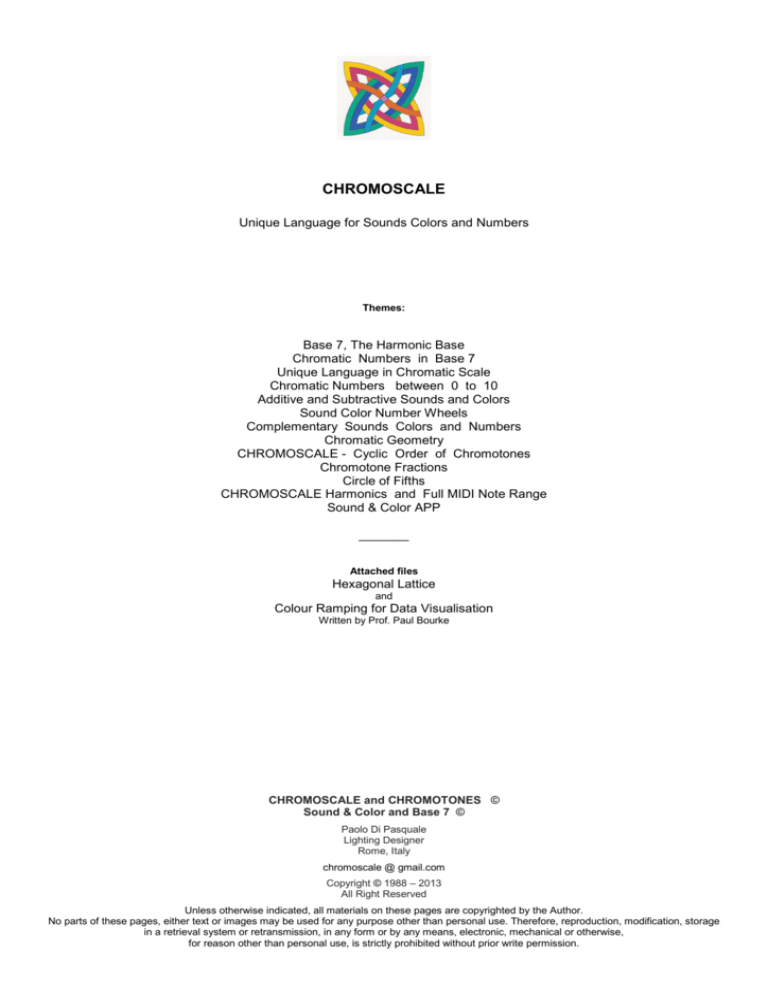
CHROMOSCALE
Unique Language for Sounds Colors and Numbers
Themes:
Base 7, The Harmonic Base
Chromatic Numbers in Base 7
Unique Language in Chromatic Scale
Chromatic Numbers between 0 to 10
Additive and Subtractive Sounds and Colors
Sound Color Number Wheels
Complementary Sounds Colors and Numbers
Chromatic Geometry
CHROMOSCALE - Cyclic Order of Chromotones
Chromotone Fractions
Circle of Fifths
CHROMOSCALE Harmonics and Full MIDI Note Range
Sound & Color APP
_______
Attached files
Hexagonal Lattice
and
Colour Ramping for Data Visualisation
Written by Prof. Paul Bourke
CHROMOSCALE and CHROMOTONES ©
Sound & Color and Base 7 ©
Paolo Di Pasquale
Lighting Designer
Rome, Italy
chromoscale @ gmail.com
Copyright © 1988 – 2013
All Right Reserved
Unless otherwise indicated, all materials on these pages are copyrighted by the Author.
No parts of these pages, either text or images may be used for any purpose other than personal use. Therefore, reproduction, modification, storage
in a retrieval system or retransmission, in any form or by any means, electronic, mechanical or otherwise,
for reason other than personal use, is strictly prohibited without prior write permission.
BASE 7
The Harmonic Base
The Base 7 is composed from the numbers 0 , 1 , 2 , 3 , 4 , 5 , 6
Table from 1 to 100 in BASE 7
Six numbers, six times present
while the 0 is present only in
the external perimeter
This is the harmonic equilibrium of Base 7
(*)
for the differences with Base 10, please visit
www.baseseven.com
“exploration between Base 7 and Base 10”
Numerical Table of Base 7 associating numbers with the seven colors of the rainbow.
Chromatic Numbers in Base 7
Hexagonal Table of Base 7 associating numbers with colors.
System where the numbers will be chromatic with the Base 7 characteristics and harmonies.
The hexagon has many interesting properties, and the result is a polygonal table constructible with elementary geometry.
We obtain a shape of hexagram similar to the Koch Snowflake
for this association,
please visit “Texture and Colour”
Prof. Paul Bourke web pages
http://paulbourke.net/texture_colour/
about Hexagonal Table in Base 7
see also attached files, page 14 - 18
“Hexagonal Lattice”
Written by Prof. Paul Bourke
Unique Language in “Chromatic Scale”
Correspondence of Sounds, Colors and Numbers in Base 7
It should be emphasized that to pass from one harmonic NOTE to the next harmonic of the same NOTE is enough to double the
frequency in Hz. Theoretically, if we double the frequency of the INFRARED we meet on frequency of the ULTRAVIOLET.
Based on this principle, we proceed multiplying by 2 the frequency in Hertz of a TONE until you get close to values in GHz of the
visible spectrum. In fact, if we multiply by 2^40 the frequency of 369,994 Hz of F# we obtain 406.813 GHz,
frequency that corresponds at the border-line of the INFRARED.
We proceed with this system for all the TONES that make up the "Chromatic Scale" by completing the following Table:
Base 7 - Chromatic Numbers between 0 and 10
10/15 = 0,404040401 (in Base 10 7/12 = 0,58333333L.)
One Harmonic of “Equal Tempered Scale” is composed by 12 Tones.
Number 12 of Base 10 correspond at number 15 in Base 7
First Harmonic is from 0 to 10
The corresponding numbers of Tones in first harmonic are between 0 and 10
One tone is 10/15
10/15 = 0,40404040L
(F#0 = 0 and F#1 = 10)
0,00000000 F#
0,00000000 + 0,40404040
1,11111111 + 0,40404040
2,22222222 + 0,40404040
3,33333333 + 0,40404040
4,44444444 + 0,40404040
5,55555555 + 0,40404040
=
=
=
=
=
=
0,40404040
1,51515151
2,62626262
4,04040404
5,15151515
6,26262626
G
A
B
C#
D#
F
0,40404040 + 0,40404040
1,51515151 + 0,40404040
2,62626262 + 0,40404040
4,04040404 + 0,40404040
5,15151515 + 0,40404040
6,26262626 + 0,40404040
= 1,11111111
= 2,22222222
= 3,33333333
= 4,44444444
= 5,55555555
= 10,00000000
(1 octave up)
about RGB, CMY, HSL and
Colour Ramping for Data Visualisation
see attached files, page 19 - 20
Written by Prof. Paul Bourke
G#
A#
C#
D
E#
F#
Additive and Subtractive in Base 7
Primary colors are sets of colors that can be combined to make a usefull range of colors.
For humans applications, three primary colors are usually used, since human color vision is trichromatic.
Additive color primaries are the secondary subtractive colors, or vice versa.
Primary colors are not a fundamental property of light but are related to the physiological response of the eye to light.
Fundamentally, light is a continuous spectrum of the wavelengths that can be detected by the human eye, an infinitedimensional stimulus space. However, the human eye normally contains only three types of color receptors,
called cone cells. Each color receptor responds to different ranges of the color spectrum. Humans and other species
with three such types of color receptors are known as trichromats. These species respond to the light stimulus via a
three-dimensional sensation, which generally can be modeled as a mixture of three primary colors.
Before the nature of colorimetry and visual physiology were well understood, scientists such as Thomas
Young, James Clark Maxwell, and Hermann von Helmholtz expressed various opinions about what should be the
three primary colors to describe the three primary color sensations of the eye. Young originally proposed red, green,
and violet, and Maxwell changed violet to blue; Helmholtz proposed "a slightly purplish red, a vegetation-green,
slightly yellowish (wave-length about 5600 tenth-metres), and an ultramarine-blue (about 4820)".
http://en.wikipedia.org/wiki/Primary_color
Correspondence of Sounds, Colors and Numbers
regarding Primary Additive and Primary Subtractive
PRIMARY ADDITIVE
G#
C
E
RED
GREEN
BLUE
1,1111111
3,3333333
5,5555555
656,529 nm.
521,087 nm.
413,587 nm.
415,304 Hz.
523,251 Hz.
659,255 Hz.
PRIMARY SUBTRACTIVE
F#
A#
D
MAGEN
YELLO
CYAN
0,0000000
2,2222222
4,4444444
736,929 nm.
584,901 nm.
464,236 nm.
369,994 Hz.
466,163 Hz.
587,329 Hz.
Primary ADDITIVE Sounds
= G#, C, E
Primary SUBTRACTIVE Sounds = D, F#, A#
Sound-Color-Number Wheels
A wheel with primary and secondary colors is traditional in the science as in the arts.
Sir Isaac Newton developed the first circular diagram of colors around the 1704. Since then, any color wheel
which presents a logically arranged sequence of pure hues has merit.
1704 – Isaac Newton
1776 – Moses Harris
1810 – Wolfgang Goethe .
Before the first circular diagram of colors, in 1558 Gioseffo Zarlino
in his book “Le Istitioni Harmoniche” draws the first wheel of sounds titled “Numeri sonori”
This is the Sound Color Wheel in Base 7
Complementary Sounds, Colors and Numbers
In color theory, two colors are called complementary if, when mixed in proper proportion,
they produce a neutral color (grey, white, or black).
In roughly-percentual color models, the neutral colors (grey, white, or black) lie around a central axis.
For example, in the HSV color space,
complementary colors (as defined in HSV) lie opposite each other on any horizzontal cross-section.
Thus, in CIE 1931 color space a color of a particular dominant wavelenght can be mixed with
a particular amount of the “complementary” wavelenght to produce a neutral color (grey or white)
In the RGB color model (and derived models such as HSV)
Primary colors and secondary colors are paired in this way
RED – CYAN
GREEN – MAGENTA
BLUE – YELLOW
Anyway we can apply the same theory of colors either for sounds and Base 7 numbers
Complementary
Analogous
Triad
Complementary
Colors and Sounds that are opposite each other on the wheel are considered to be complementary
Analogous
Analogous scheme use Colors and Sounds that are next to each other on the wheel
Triad
A triadic scheme uses Colors and Sounds that are evenly spaced around the wheel
Chromatic Geometry
The wheel of sounds in “equal tempered scale” is representable by an hypocycloid curve with twelve cusps.
In geometry a hypocycloid is a special plane curve generated by the trace of a fixed point on a small circle that rolls within a large
circle. The red curve is the hypocycloid traced as the smaller black circle rolls around inside the larger blue circle.
(parameters are R = 12, r = 1 and so k = 12)
The sine wave or sinusoid is a mathematical curve that described a smooth
repetitive oscillation. The sine wave is important in physic because it retains
its waveshape when added to another sine wave of the same frequency and
arbitrary phase and magnitude.
It is the only periodic wave form that has this property.
This wave pattern occurs often in nature, including, sound waves, light waves
and ocean waves.
To the human ear, a sound that is made up of more than one sine wave will
either sound “noisy” or will have detectable harmonics. This may be
described as a different timbre.
( http://en.wikipedia.org/wiki/Sine_wave )
The correspondence of Sounds, Colors and Base 7 Numbers respects these mathematical and physical principles.
Chromatic Numbers between 0 and 10
0,00000000 + 0,40404040
1,11111111 + 0,40404040
2,22222222 + 0,40404040
3,33333333 + 0,40404040
4,44444444 + 0,40404040
5,55555555 + 0,40404040
=
=
=
=
=
=
0,40404040
1,51515151
2,62626262
4,04040404
5,15151515
6,26262626
0,00000000 F#
G
0,40404040 + 0,40404040
A
1,51515151 + 0,40404040
B
2,62626262 + 0,40404040
C#
4,04040404 + 0,40404040
D#
5,15151515 + 0,40404040
F
6,26262626 + 0,40404040
= 1,11111111
= 2,22222222
= 3,33333333
= 4,44444444
= 5,55555555
= 10,00000000
(1 octave up)
G#
A#
C#
D
E#
F#
CHROMOSCALE ©
Cyclic Order in Base 7
Cyclic Number is an integer in which cyclic permutation of the digits are successive multiples of the number.
Every proper multiple of a cyclic number (that is, a multiple having the same number of digits) is a rotation.
In Base 10 the first “prime number” that produce cyclic numbers is the 7
b = 10, p = 7 the cyclic number is 0,142857142857L.
A cyclic order is a way to arrange a set of objects in a circle.
Set with a “Cyclic Order” is called a cyclically ordered set or simply a cycle.
Monotone functions
The "cyclic order = arranging in a circle" idea works because any subset of a cycle is itself a cycle.
In order to use this idea to impose cyclic orders on sets that are not actually subsets of the unit circle in the plane,
it is necessary to consider functions between sets.
A function between two cyclically ordered sets, f : X → Y, is called a monotonic function or a homomorphism
if it pulls back the ordering on Y: whenever [f(a), f(b), f(c)], one has[a, b, c].
Equivalently, f is monotone if whenever [a, b, c] and f(a), f(b), and f(c) are all distinct, then [f(a), f(b), f(c)].
Based on this principle, born the CHROMOSCALE in 66 CHROMOTONES
The first known occurrence of explicitly infinite sets is in Galileo's last book Two New Sciences.
Galileo argues that the set of squares is the same size as S = {1,4,9,16,25,...} is the same size as N = {1,2,3,4,5,L}
because there is a one-to-one correspondence : 1↔1, 2↔4, 3↔9, 4↔16, 5↔25, LLL
And yet, as he says, S is a proper subset of N and S even gets less dense as the numbers get larger.
Chromotones in CHROMOSCALE
CHROMOSCALE with its 66 Chromotones give the possibility to develop the musical composition
with harmonic microtonality and just intonation
CIRCLE of FIFTHS
The Circle of Fifths is a sequence of pitches or key tonalities, represented as a circle,
in which the next pitch is found seven semitones higher than the last.
The Sound Color Wheel on the left shows the Base 7 Cyclic Numbers,
while on the right the wheel shows the Circle of Fifths in C Major.
At the top of Circle the key of C Major has non sharp or flats.
Starting from the apex and proceeding clockwise by ascending fifths,
we can subtract the value of B (2,626262) to obtain the key of G that has one sharp.
From the key of G, proceeding to subtract 2,626262 to obtain the key of D that has two sharps,
and so on.
Similarly proceeding counterclockwise from the apex by descending fifths,
proceeding to add 2,626262 to obtain the key of F that has one flat,
proceeding to add 2,626262 to obtain the key of Bb that has two flats,
and so on.
We can construct geometrically all Circle of Fifths, Fourths and Thirds with simple algebraic formulas.
The same rule can be applied by including all the Chromotones of CHROMOSCALE.
CHROMOSCALE Harmonics and Full MIDI Note Range
Sound & Color APP
This Calculator converts numbers and related transaction in numeric form, it shows the corresponding value
of sounds in Hz., Colors in Nanometers, RGB, CMYK, XYZ, and the device emits the resulting sound.
SOUND & COLOR CALCULATOR
with Cycle in 7 Harmonics
it is possible to build musical scores using
mathematical functions and formulas simply by playing
with sound and color bands.
THE CALCULATOR CAN WORK IN FOUR
DIFFERENT MODES
BASE 7 CALCULATOR – Chromatic Numbers
BASE 10 CALCULATOR – Numerical Sequence
COLOR nm. to SOUNDS Converter
SOUND Hz. to COLORS Converter
about
SOUND & COLOR APP
please visit
https://itunes.apple.com/us/app/sound-color/id579920437?l=it&ls=1&mt=8
Colour Ramping for Data Visual isation
Written by Paul Bourke
July 1996
Contribution: Ramp.cs by Russell Plume in DotNet C#.
This note introduces the most commonly used colour ramps for mapping colours onto a range of scalar values as is
often required in data visualisation. The colour space will be based upon the RGB system.
Colour
The most commonly used colour ramp is often refer to as the "hot- to-cold" colour ramp. Blue is chosen for the low
values, green for middle values, and red for the high as these seem "intuitive" bounds. One could ramp between these
points on the colour cube but this involves moving diagonally across the faces of the cube. Instead we add the
colours cyan and yellow so that the colour ramp only moves along the edges of the colour cube from blue to red.
This not only makes the mapping easier and faster but introduces more colour variation. The following illustrates
the path on the colour cube.
The colour ramp is shown below along with the transition values.
Again there is a linear relationship of the scalar value with colour within each of the 4 colour bands.
In some applications the variable being represented with the colour map is circular in nature in which case a cyclic
colour map is desirable. The above can be simply modified to pass through magenta to yield one of many possible
circular colour maps.
RGB and CMY
A colour space is a means of uniquely specifying a colour. There are a number of colour spaces in common usage
depending on the particular industry and/or application involved. For example as humans we normally determine
colour by parameters such as brightness, hue, and colourfulness. On computers it is more common to describe colour
by three components, normally red, green, and blue. These are related to the excitation of red, green, and blue
phosphors on a computer monitor. Another similar system geared more towards the printing industry uses cyan,
magenta, and yellow to specify colour, they are related to the reflectance and absorbance of inks on paper.
HSL, Hue Saturation and Lightness
The HSL colour space has three coordinates: hue, saturation, and lightness (sometimes luminance) respectively, it is
sometimes referred to as HLS. The hue is an angle from 0 to 360 degrees, typically 0 is red, 60 degrees yellow, 120
degrees green, 180 degrees cyan, 240 degrees blue, and 300 degrees magenta.
Saturation typically ranges from 0 to 1 (sometimes 0 to 100%) and defines how grey the colour is, 0 indicates grey and
1 is the pure primary colour. Lightness is intuitively what it's name indicates, varying the lightness reduces the values
of the primary colours while keeping them in the same ratio. If the colour space is represented by disks of varying
lightness then the hue and saturation are the equivalent to polar coordinates (r,theta) of any point in the plane.
http://paulbourke.net/texture_colour/colourspace/








